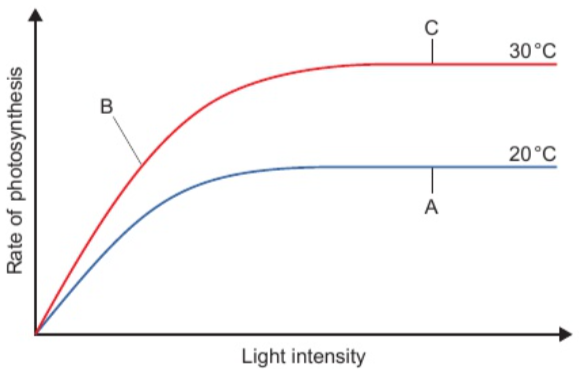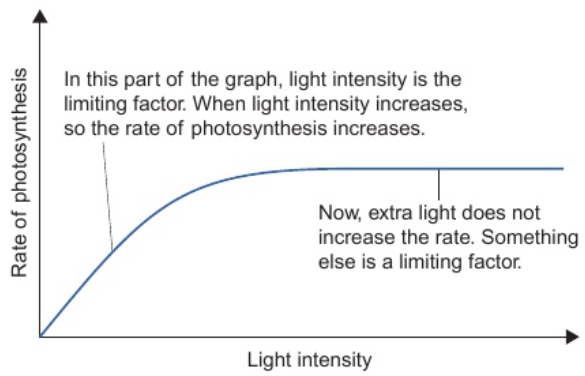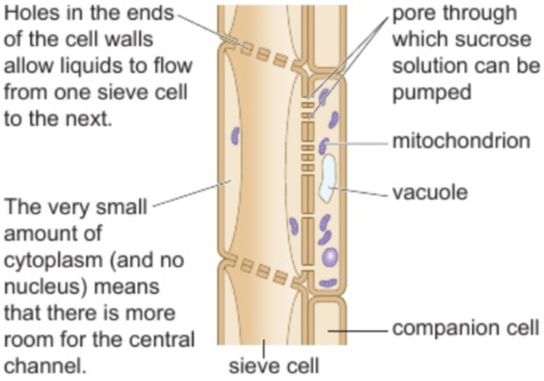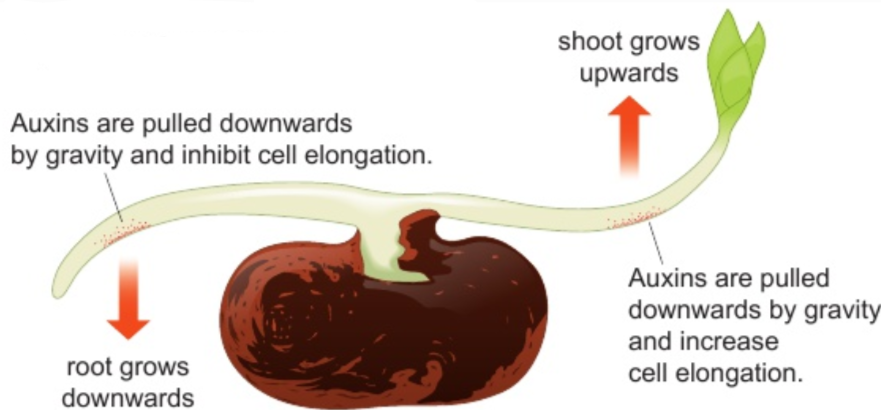biology - plant structures & their functions (6.1 - 6.17)
1/38
There's no tags or description
Looks like no tags are added yet.
Name | Mastery | Learn | Test | Matching | Spaced |
|---|
No study sessions yet.
39 Terms
biomass
materials in an organism
6.1 photosynthetic organisms
produce their own biomass - main producers of food & biomass
6.2 photosynthesis in plants & algae
endothermic reaction - energy enters from surroundings, products have more energy than reactants
carbon dioxide + water —energy transferred by light→ glucose + oxygen
6.3 temp. effect as limiting factor on rate of photosynthesis
temp. increases = rate of photosynthesis increases
reactions in photosynthesis catalysed by enzymes - work better at warmer temps.
6.3 light intensity effect as limiting factor on rate of photosynthesis
light intensity increases = rate of photosynthesis increases
light needed for reaction
6.3 CO2 conc. effect as limiting factor on rate of photosynthesis
CO2 conc. increases = rate of photosynthesis increases
CO2 needed for reaction
limiting factor
factor that prevents rate increasing
6.4 interactions of temp., light intensity & CO2 conc. in limiting rate of photosynthesis
changing supply of limiting factor changes rate of photosynthesis
in graph:
lower line levels off - temp. is limiting factor
increase temp. - higher rates of photosynthesis (upper line)

6.5 core practical: investigate effect of light intensity on rate of photosynthesis
choose diff. distances between algae & lamp to use
need one clear glass bottle for each distance & one extra bottle
add 20 algal balls to each bottle
add same amount of indicator solution to each bottle & put bottle caps on
compare colour in bottle with pH range (from range of bottles showing colours of indicator at diff. pHs) to find pH at start
place tank of water between lamp & area you will place bottles
cover one bottle in foil
measure diff. distances from lamp & place bottles at those distances
place bottle in foil next to bottle closest to lamp
turn on lamp & wait until you can see obvious changes in colours in bottles
compare colours of bottles with pH range bottles & record pHs of solutions in bottles
for each bottle, calculate: change in pH/hour
plot suitable graph/chart of results
6.6 how is rate of photosynthesis is directly proportional to light intensity?
straight line = linear relationship between 2 variables
line goes through origin = 2 variables in direct proportion
rate of photosynthesis directly proportional to light intensity until limiting factor starts to effect

6.6 how is rate of photosynthesis is inversely proportional to distance from light source? (inverse square law)
lnew inversely proportional to d2new
double distance from light source: light intensity = 1/22 = 1/4 times og.
halve distance from light source: light intensity = 1/1/22 = 1/1/4 = 4 times og.

6.7 how is structure of root hair cells adapted to absorb water & mineral ions?
outer surfaces of roots covered with root hair cells
hairs have:
large surface area - water & mineral ions absorbed quickly
thin cell walls - flow over water into cells not slowed down
6.8 how is structure of xylem adapted to its function?
lignified dead cells in xylem transport water & minerals through plant
thick side walls & rings of hard lignin form rigid tubes - won’t burst/collapse from water pressure, provide support
dead cells have no cytoplasm - form empty tube for water to flow through
tiny pores - allow water & mineral ions to enter & leave xylem vessels
no cell walls between cells - water flow not slowed down

6.8 how is structure of phloem adapted to its function?
living cells in phloem use energy to transport sucrose around plant
holes in ends of cell walls - liquids flow from one sieve to next
pore - sucrose solution pumped through
very small amount of cytoplasm (& no nucleus) - more room for central channel

6.9 how are water & mineral ions transported through plant by transpiration (xylem vessels)?
xylem vessels form tiny continuous pipes - roots → leaves
inside vessels - unbroken chain of water (weak forces of attraction between water molecules)
water evaporates from xylem vessels in leaf - water pulled up xylem vessels
water vapour diffuses out leaf - more water evaporates from xylem in leaf
6.9 stomata structure & function
stoma/stomata: microscopic pore on leaves
let CO2 diffuse into leaf
opened & closed by specialised guard cells (light sensitive)
when light/lots water:
don’t need to conserve water
guard cells turgid (osmosis - water flows in)
stoma open
CO2 diffuses in for photosynthesis
when night/little water:
need to conserve water
guard cells flaccid (osmosis - water flows out)
stoma closed
conserves water vapour
no photosynthesis at night - no CO2 needed
transpiration definition
flow of water into root → up stem → out leaves
6.10 how is sucrose transported around plant by translocation?
sucrose translocated in holes in sieve tubes of phloem
large central channel in each sieve cell connected to next sieve cell by holes
companion cells actively pump sucrose into/out of sieve cells that form sieve tubes
sucrose pumped into sieve tubes → increased pressure → sucrose solution flows up to growing shoots/down to storage organs
where does sucrose come from?
made from glucose & starch made by photosynthesis
translocation definition
transport of sucrose in phloem
6.11 how is structure of leaf adapted for photosynthesis?
large surface area - maximise light absorption
chlorophyll - traps energy transferred by light
chloroplasts move towards/away from light - protection from damage by very bright light
network of xylem vessels - provides water for photosynthesis
epidermis cells (outer layer of leaf) are transparent - light passes through easily
6.11 how is structure of leaf adapted for gas exchange?
stomata - lets CO2 for photosynthesis diffuse into leaf through it
thin - short diffusion distance for CO2 before reaching photosynthesising cells
irregularly shaped spongy cells - don’t fit together well, create air spaces → gases diffuse easily
6.12 effect of light intensity on water uptake by plant
greater light intensity → stomata wider → faster diffusion of water → more water pulled up plant
6.12 effect of air movement on water uptake by plant - wind, humidity
water molecules diffuse down concentration gradient out of leaf - water vapour conc. in air spaces in leaf > outside
bigger difference between concs. = steeper gradient → faster diffusion
wind - windy → moves water molecules away from stomata → faster diffusion
humidity - low humidity → less water vapour in air → faster diffusion
6.12 effect of temp. on water uptake by plant
higher temp. → particles move faster → diffuse faster
6.13 rate calculations for transpiration
distance moved by bubble/time taken
e.g. mm/min
6.14 plants adapted to survive in extreme environments - leaf size & shape
broad-leaved deciduous plants lose leaves in winter - prevents water loss when soil frozen
conifers have needle-shaped leaves - smaller surface area, very thick cuticle, less wind resistance, collect less snow
6.14 plants adapted to survive in extreme environments - cuticle
waxy & waterproof
helps prevent water loss
helps stop microorganisms & water entering leaf
6.14 plants adapted to survive in extreme environments - stomata
reduce water loss - trap water vapour close to leaves → slows rate of diffusion out of leaves
conifers have stomata in small pits - water vapour collects (less exposed to air movement)
(other plants - tiny hairs trap water vapour)
epidermis cells
hold leaf together, protect cells inside, produce waterproof waxy cuticle
(outer layers of leaf)
stimulus
change in environment that causes response by organism
tropism - positive & negative
respond to stimulus - grow towards/away from it
positive - tropism towards stimulus
negative - tropism away from stimulus
phototropism definition
tropism caused by light
gravitropism definition
tropism caused by gravity
6.15 how do auxins control & coordinate plant growth & development - phototropism?
shoots - positively phototrophic; roots - negatively phototrophic
auxins cause positive phototropism
how auxins work:
produced in tip of shoot
cause cell elongation
shoot grown with light only from one direction
auxins move to shaded side of shoot
cells on shaded side elongate more
shoot grows towards light

6.15 how do auxins control & coordinate plant growth & development - gravitropism?
auxins cause positive gravitropism
helps roots anchor plant in place & reach moisture underground
how auxins work:
found in root tips
have opposite effects to in shoots
inhibit cell elongation
pulled downwards by gravity
cells stop elongating
root grows down

6.16 commercial uses of auxins in plants
make some plants grow uncontrollably - can kill them
selective weedkillers (artificial auxins):
kill plants with broad not narrow leaves
farmers can kill weeds in wheat field without affecting crop
rooting powders:
make plant cuttings develop roots quickly
lots of identical plants produced quickly using cuttings (vs seed)
6.16 commercial uses of gibberellins in plants
naturally released inside seed - start germination
germination:
some seeds need darkness/cold before germination
make plants germinate without this
fruit & flower formation:
photoperiodism: organism’s response to number of daylight hours in day
some plants use this to flower at certain time - e.g. suitable pollinators around, not too cold
flower growers override photoperiodism
producing seedless fruit:
many plants only produce seeds after pollination
make some plants produce fruit without this
can produce bigger fruits
6.16 commercial uses of ethene in plants
fruit ripening
unripe fruits (vs ripe) - easier to transport without damaging, kept longer in cold storage without going off
pick unripe fruit & ripen it when needed with ethene gas